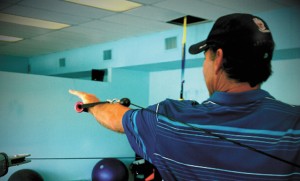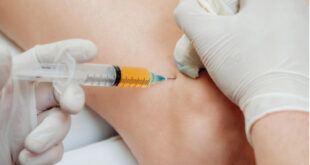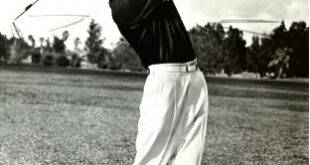By Domenic J. Pompile, PT, CSCS, Licensed Physical Therapist –
 Shoulder injuries are among one of the most common injuries today that affect individuals on a daily basis. The largest degree of my patient population seeks therapy due to shoulder injuries. Whether the shoulder has been injured due to an accident, surgery, non-use or a sports related activity; rehabilitation to the shoulder is a critical part in getting the patient back to his/her quality of life and function.
Shoulder injuries are among one of the most common injuries today that affect individuals on a daily basis. The largest degree of my patient population seeks therapy due to shoulder injuries. Whether the shoulder has been injured due to an accident, surgery, non-use or a sports related activity; rehabilitation to the shoulder is a critical part in getting the patient back to his/her quality of life and function.
Ergonomic injuries cost $30.6 billion annually with single injury costs typically ranging from $40,000 to $100,000 per incident. While back injuries are the most frequently reported on-the-job injuries, shoulder injuries keep people out of work the longest: 30 days, compared to back injuries at 12 days.
Shoulder injuries are very common due to the large degree of motion in the shoulder joint, in tandem with the lack of shoulder stability. Whether it is doing household chores, working out at the gym or playing the sports we love, the shoulder can be easily injured.
Common sprains and strains to the shoulder joint may be treated with rest, anti inflammatory medication, combination of ice and or heat and a basic home exercise program (HEP). Many times the shoulder becomes injured in which it will require physical therapy. Physical therapy for the shoulder joint is focused on decreasing pain, increasing active range of motion (AROM)/function, strength, and restoring proper mechanics, in conjunction with quality of life to the affected area. At times, shoulder surgery is required due to more extensive injuries that may have been sustained. Therapy is dependent upon the procedures performed, along with the protocol established by the physician. Again, therapy will be focused on decreasing pain, increasing range of motion, increasing strength and restoring proper function to the affected area.
Many people ask “How did I tear my shoulder? I don’t remember falling on it or injuring it!” Common rotator cuff tears or shoulder injuries such as impingement syndrome, bursitis, and labral tears occur due to poor mechanics of the shoulder joint. Repetitive use of the arm and shoulder, along with poor posture and weakened muscles surrounding the shoulder joint, will lead to wear and tear on the shoulder joint.
Overtime, tendons may become injured or the patient may experience bursitis. A major role in restoring proper function to the shoulder joint is to educate the patient on proper posture and mechanics of the shoulder joint. This will consist of establishing proper posture to the shoulder blade, arm and stabilizing the accompanying muscles that surround and act upon the shoulder joint. The shoulder joint itself is one of the most mobile joints in the human body and is also the least stable. Shoulder injuries are bound to happen at some point in time. Preparing the shoulder to handle stress, while maintaining proper posture and ergonomics is an effective way in which to decrease shoulder injuries.
Common shoulder injuries are treated using modalities such as ultrasound, electrical stimulation, ice, heat, soft tissue massage and general strengthening to the shoulder and rotator cuff muscles. Unfortunately, many times this is just touching the tip of the true “root cause” of the problem due to the extensive mobility that the shoulder joint allows, along with its lack of stability. Addressing the role and function of the shoulder blade is imperative in regards to effectively treating the shoulder. If the shoulder blade becomes restricted in motion, it will then cause restriction to the shoulder joint itself. Addressing the true “cause” of the shoulder injury with a differential diagnosis process is the foundation in effectively treating the shoulder. Once the true “root cause” is established, an effective treatment plan can be established to restore proper function to the shoulder joint.
Following stabilization activities, range of motion activities and general strengthening to the proper muscles acting upon the shoulder joint, the individual will be able to return to their daily activities and get back in the game of life.
Domenic J. Pompile,
PT, CSCS, Licensed
Physical Therapist
Domenic J. Pompile is a licensed physical therapist and certified strength and conditioning specialist and co-owner of Vado Therapy. He graduated from the University of Hartford with a Bachelors of Science degree. He knew by the age of 14 that he wanted to be a physical therapist after several major brain surgeries changed his outlook on life. This fostered his passion for health, fitness and creating physical well being. Due to his passion for health and fitness he researched, studied and received his Certified Strength and Conditioning Specialist certification right after graduating physical therapy school.
Through the past 13 years Domenic has evolved his passion for physical therapy, fitness and overall health and wellbeing into a comprehensive therapy program that benefits individuals from all walks of life. He has worked with Olympic athletes, professional athletes from the NFL, MLB, NHL, WBA, PGA, weekend warriors and geriatric clients looking to improve their function and overall wellbeing. He is motivated by the challenge of restoring an individual’s quality of life, giving a patient the ability to walk again or perform an activity that they never thought they could achieve after a surgery or major injury.
Domenic truly enjoys the challenge of dealing with a wide variety of injuries and educating, empowering and restoring a patient’s confidence and quality of life while providing a high quality of physical therapy and health services.
vado therapy | 561-450-6487 | www.vadotherapy.com
Check Also
The Mighty Maestro: Bob “Mighty Mite” Toski’s Enduring Legacy at 98
In the warm glow of a spring evening in Delray Beach, Florida, a remarkable celebration …
 South Florida Health and Wellness Magazine Health and Wellness Articles
South Florida Health and Wellness Magazine Health and Wellness Articles




